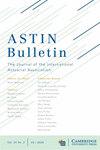具有索赔开放性的集体保留模式
IF 1.8
3区 经济学
Q2 ECONOMICS
引用次数: 2
摘要
摘要本文介绍了一个简单的基于索赔计数和支付动态的汇总保留模型,该模型允许索赔关闭和重新开放。建模从离散时间的个体泊松过程索赔动态开始,跟踪事故年份,报告年份和付款延迟。这种建模方法与支撑所谓的双链梯模型的方法密切相关,它允许产生单独报告但未结算的储量和已发生但未报告的储量。即使引入索赔关闭和重新开放将产生新的依赖类型,也可以使用灵活的参数化,例如,广义线性模型(GLM),其参数可以基于使用准似然理论的汇总数据进行估计。此外,有可能获得可解释和显式的矩计算,以及在合同数量趋于无穷时具有归一化储量的一致性。此外,通过获得矩的简单解析表达式,自举预测储量的均方误差的计算成本很低。该模型的性能是用一个灵活的GLM参数化对非平凡的模拟索赔数据进行评估。这个数字说明与不考虑索赔结案和重新开业的模型相比,有明显的改进。结果也被认为与不考虑索赔开放性的汇总数据的机器学习模型的质量相当。本文章由计算机程序翻译,如有差异,请以英文原文为准。
A COLLECTIVE RESERVING MODEL WITH CLAIM OPENNESS
Abstract The present paper introduces a simple aggregated reserving model based on claim count and payment dynamics, which allows for claim closings and re-openings. The modelling starts off from individual Poisson process claim dynamics in discrete time, keeping track of accident year, reporting year and payment delay. This modelling approach is closely related to the one underpinning the so-called double chain-ladder model, and it allows for producing separate reported but not settled and incurred but not reported reserves. Even though the introduction of claim closings and re-openings will produce new types of dependencies, it is possible to use flexible parametrisations in terms of, for example, generalised linear models (GLM) whose parameters can be estimated based on aggregated data using quasi-likelihood theory. Moreover, it is possible to obtain interpretable and explicit moment calculations, as well as having consistency of normalised reserves when the number of contracts tend to infinity. Further, by having access to simple analytic expressions for moments, it is computationally cheap to bootstrap the mean squared error of prediction for reserves. The performance of the model is illustrated using a flexible GLM parametrisation evaluated on non-trivial simulated claims data. This numerical illustration indicates a clear improvement compared with models not taking claim closings and re-openings into account. The results are also seen to be of comparable quality with machine learning models for aggregated data not taking claim openness into account.
求助全文
通过发布文献求助,成功后即可免费获取论文全文。
去求助
来源期刊

ASTIN Bulletin
数学-数学跨学科应用
CiteScore
3.20
自引率
5.30%
发文量
24
审稿时长
>12 weeks
期刊介绍:
ASTIN Bulletin publishes papers that are relevant to any branch of actuarial science and insurance mathematics. Its papers are quantitative and scientific in nature, and draw on theory and methods developed in any branch of the mathematical sciences including actuarial mathematics, statistics, probability, financial mathematics and econometrics.
 求助内容:
求助内容: 应助结果提醒方式:
应助结果提醒方式:


